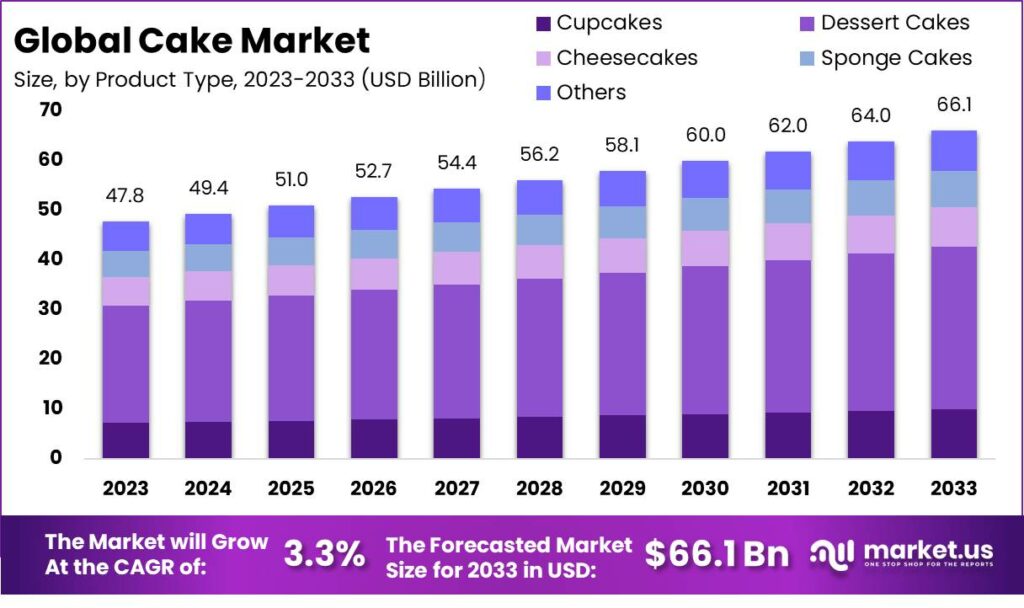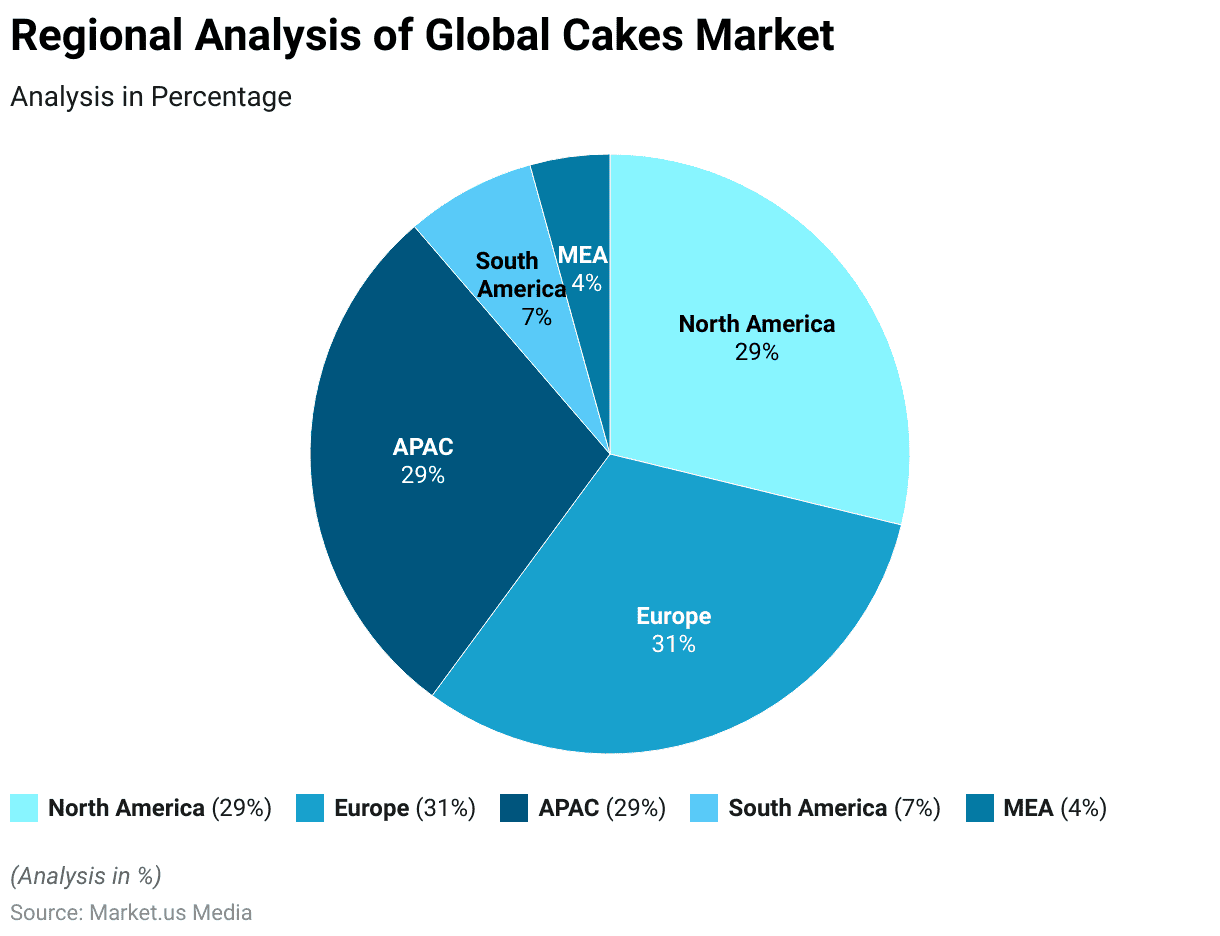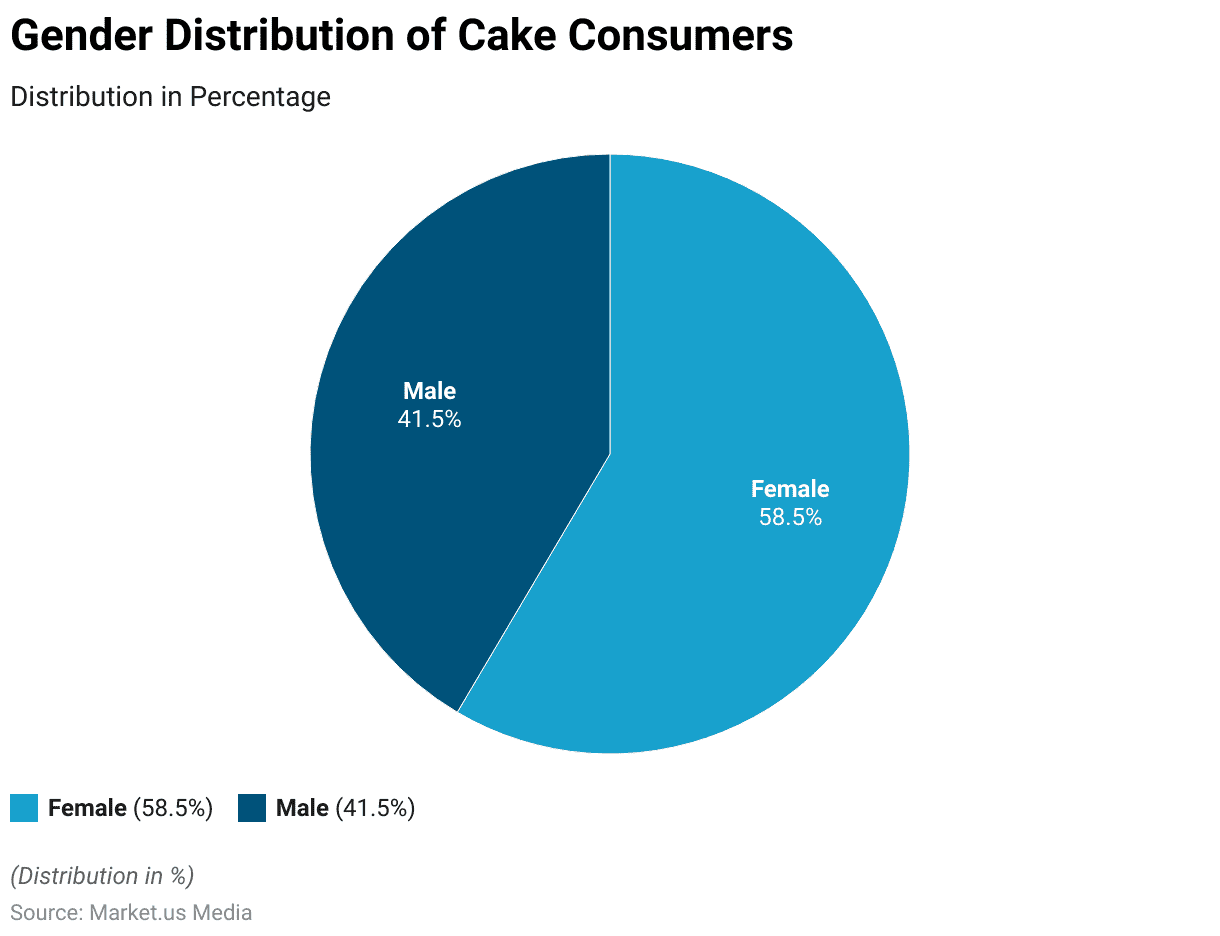Table of Contents
Introduction
According to Cakes Statistics, The cake industry is a significant part of the broader bakery market, offering a wide variety of cake products, from classic sponge cakes to specialty and artisanal options. Consumer preferences heavily influence the demand for cakes, with a rising interest in healthier alternatives and customization.
Key players in the industry range from large commercial bakeries with established brands to smaller regional and local businesses. Challenges include health concerns regarding sugar and calories, intense competition, and supply chain disruptions. However, opportunities exist in embracing natural product trends, diversifying offerings, and exploring online sales channels.
Editor’s Choice
- The global cake market generated a revenue of USD 47.8 billion in 2023.
- In North America, it holds a significant share of 28.8%, highlighting the popularity of cakes in this region.
- MCKEE Foods emerges as the leading player in the cakes market, commanding a substantial 19% market share.
- Remarkably, a substantial 77% of consumers prioritize taste as the foremost consideration when selecting cakes, cake bars, or sweet baked goods, with price ranking as the second most influential factor.
- Among age groups, individuals aged 20 to 30 constitute the largest segment, accounting for a significant 44.9% of cake consumers.
- Among cake enthusiasts, females dominate the consumer base, representing a majority share of 58.5%.
- Recent survey findings revealed that cake was a common presence in the office, with 86% of respondents reporting its availability at least “once or twice a week.”

Global Cakes Market Overview
Global Cakes Market Size
- The cakes market is showing a promising trend of consistent growth over the forecasted years at a CAGR of 3.3%.
- Starting at USD 47.8 billion in 2023, the market’s revenue is expected to steadily increase year by year. By 2024, it is projected to reach USD 49.4 billion, followed by USD 51.0 billion in 2025.
- This upward trajectory continues with revenue figures of USD 52.7 billion in 2026, USD 54.4 billion in 2027, and USD 56.2 billion in 2028.
- The market is anticipated to maintain its growth momentum, surpassing USD 60.0 billion by 2030, and reaching USD 66.1 billion by 2033.
Regional Analysis of the Global Cakes Market
- The cake market exhibits a global presence with varying regional market shares.
- In North America, it holds a significant share of 28.8%, highlighting the popularity of cakes in this region.
- Europe closely follows with a substantial market share of 31.3%, reflecting strong demand for cakes across European countries.
- The Asia-Pacific (APAC) region contributes significantly as well, accounting for 28.6% of the market, indicating a growing consumer base for cakes in this diverse and populous region.
- South America and the Middle East & Africa (MEA) regions hold smaller but notable market shares of 7.0% and 4.3%, respectively, demonstrating the global reach of the cake industry.

Key Players in the Global Cakes Market
- MCKEE Foods emerges as the leading player in the cakes market, commanding a substantial 19% market share.
- Finsbury Food Group Plc secures the second-largest market share at 17%. This indicates a significant market presence and competitive positioning within the cake industry.
- Yamazaki Baking Co., Ltd holds a noteworthy 13% market share. This suggests a strong presence, possibly driven by product innovation and quality.
- BreadTalk Group Limited captures 10% of the market share, signifying its prominence in the cake industry.
- Grupo Bimbo and Hostess Brands, LLC both share an 8% market share, indicating their equal footing within the industry.
- George Weston Limited secures a 7% market share, showcasing its relevance in the cakes market.
- Monginis holds a 6% market share, demonstrating its competitiveness in the cake industry.

Consumer Preferences for Selecting a Cake
- Remarkably, a substantial 77% of consumers prioritize taste as the foremost consideration when selecting cakes, cake bars, or sweet baked goods, with price ranking as the second most influential factor.
- Additionally, an impressive 65% of consumers express a desire for more innovative and unconventional flavor options, underscoring the potential for market growth through flavor-driven innovation.

Popular Ingredients & Flavors for Cake
- The world of cakes is constantly evolving, and consumer preferences for ingredients and flavors are no exception.
- In this context, a survey reveals the popularity of various ingredients and flavors among cake enthusiasts.
- Scone-flavored cakes take the lead with a substantial 19.14% preference rate, showcasing a penchant for the rich and crumbly texture reminiscent of scones.
- Cheesecake, known for its creamy and indulgent profile, closely follows at 15.86%, indicating a strong affinity for the beloved dessert’s essence in cake form.
- Latte-flavored cakes, with their aromatic and coffee-infused notes, capture 13.12% of the consumer preference, appealing to those who enjoy the combination of coffee and cake.
- Tea-infused cakes, at 10.26%, signify an emerging trend where the delicate flavors of various teas are being incorporated into cake recipes.

Demographics of Cake Consumers
According to Age
- Cake consumers span a wide range of age groups, and understanding their distribution is crucial for market analysis.
- Among these age groups, individuals aged 20 to 30 constitute the largest segment, accounting for a significant 44.9% of cake consumers.
- This suggests that younger adults in their twenties are particularly enthusiastic about indulging in cakes, possibly due to their diverse and adventurous palates.
- Meanwhile, the age group of 31 to 40 makes up 11.6% of cake consumers, indicating a smaller but notable presence in the market.
- The 41 to 50 age bracket represents 30.9% of consumers, showcasing a substantial portion of middle-aged individuals who appreciate cakes.
- Lastly, those aged above 51 contribute 20.6% to the consumer base, highlighting that even the older generation continues to enjoy cakes, emphasizing the timeless appeal of this sweet treat.

According to Gender
- Cake consumption is not limited by gender, but there are noticeable variations in the preferences of consumers.
- Among cake enthusiasts, females dominate the consumer base, representing a majority share of 58.5%.
- This suggests that women tend to have a higher affinity for cakes, possibly due to their inclination towards sweet and indulgent treats.
- On the other hand, males contribute to 41.5% of cake consumers, indicating a significant presence in the market.

By Education
- Cake consumers display varying educational backgrounds, shedding light on how different levels of education correlate with preferences for this indulgent dessert.
- The data reveals that individuals with a secondary education level constitute the largest segment, accounting for a significant majority at 53.6%.
- This suggests that those with a secondary education tend to form the core of cake consumers, possibly due to a combination of factors such as age and accessibility.
- Meanwhile, individuals with a university education level contribute significantly as well, representing 35.8% of the consumer base.
- In contrast, those with primary education levels make up a smaller 2.3% of consumers, while 8.3% fall into the “Others” category.

Recent Consumer Trends
- As inflation reaches historically high levels, consumers are increasingly seeking ways to economize on their food expenses.
- A significant 46% of respondents have indicated that they are reducing their purchases of breakfasts at restaurants, creating a noteworthy opportunity for expanding the range of breakfast items available in in-store bakeries.
- Although fresh bakery items are still more commonly associated with special occasions (67%) than everyday consumption (52%), there is a rising trend in spontaneous indulgence and comfort purchases.
- Notably, 31% of survey participants reported that they have increased their purchases of anytime treats in the past two years compared to the pre-pandemic period.
- Premium bakery products are primarily enjoyed in the comfort of one’s home, with 68% of respondents stating that they buy these items as treats for themselves and their families.
Health Concerns Associated with Cake Consumption
- In a research study involving nearly 1000 UK office workers, their attitudes and behaviors regarding workplace cake culture were explored.
- The findings revealed that cake was a common presence in the office, with 86% of respondents reporting its availability at least “once or twice a week.”
- Interestingly, 31% of participants attributed weight gain to office cake consumption, while 38% believed it made it challenging to maintain a healthy diet at work, and 59% felt it hindered their efforts to adhere to weight loss diets.
- This initial data seemed to favor the perspective that “office cake is detrimental.”
- However, another perspective emerged strongly. Surprisingly, 61% of respondents considered office cake to be a positive aspect, with 81% stating that it fosters camaraderie among colleagues, and 83% agreeing that it boosts people’s spirits.
Discuss your needs with our analyst
Please share your requirements with more details so our analyst can check if they can solve your problem(s)



